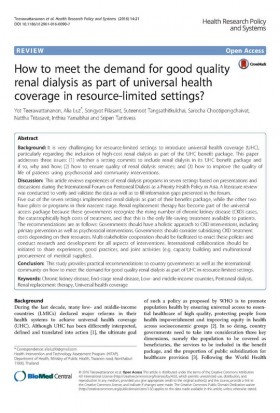This website uses cookies so that we can provide you with the best user experience possible. Cookie information is stored in your browser and performs functions such as recognising you when you return to our website and helping our team to understand which sections of the website you find most interesting and useful.
How to meet the demand for good quality renal dialysis as part of universal health coverage in resource-limited settings? (2016)

Details
Yot Teerawattananon, Alia Luz* , Songyot Pilasant, Suteenoot Tangsathitkulchai, Sarocha Chootipongchaivat, Nattha Tritasavit, Inthira Yamabhai and Sripen Tantivess
Abstract
Background: It is very challenging for resource-limited settings to introduce universal health coverage (UHC), particularly regarding the inclusion of high-cost renal dialysis as part of the UHC benefit package. This paper addresses three issues: (1) whether a setting commits to include renal dialysis in its UHC benefit package and if so, why and how; (2) how to ensure quality of renal dialysis services; and (3) how to improve the quality of life of patients using psychosocial and community interventions.
Discussion: This article reviews experiences of renal dialysis programs in seven settings based on presentations and discussions during the International Forum on Peritoneal Dialysis as a Priority Health Policy in Asia. A literature review was conducted to verify and validate the data as well as to fill information gaps presented in the forum. Five out of the seven settings implemented renal dialysis as part of their benefits package, while the other two have pilots or programs in their nascent stage. Renal replacement therapy has become part of the universal access package because these governments recognize the rising number of chronic kidney disease (CKD) cases, the catastrophically high costs of treatment, and that this is the only life-saving treatment available to patients. The recommendations are as follows: Governments should have a holistic approach to CKD interventions, including primary prevention as well as psychosocial interventions. Governments should consider subsidizing CKD treatment costs depending on their resources. Multi-stakeholder cooperation should be facilitated to enact these policies and conduct research and development for all aspects of interventions. International collaboration should be initiated to share experiences, good practices, and joint activities (e.g. capacity building and multinational procurement of medical supplies).
Conclusion: This study provides practical recommendations to country governments as well as the international community on how to meet the demand for good quality renal dialysis as part of UHC in resource-limited settings
Full Text: http://health-policy-systems.biomedcentral.com/articles/10.1186/s12961-016-0090-7




